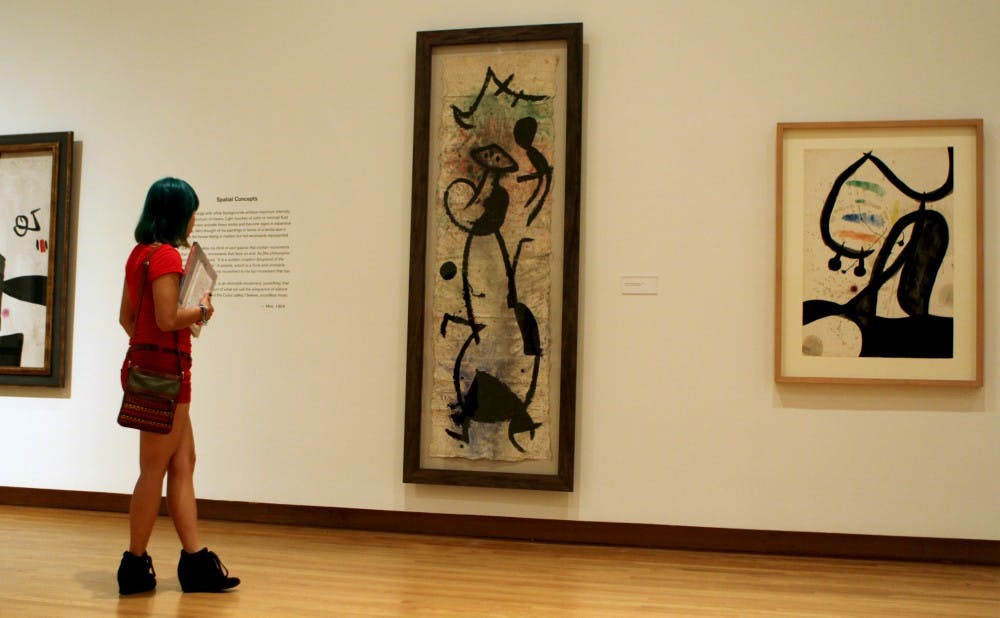A traveling exhibition originating from the Seattle Art Museum, Joan Miró’s paintings and sculptures from 1963-1981 are now on display at The Nasher Museum of Art at Duke University, inviting audiences to partake in a visceral Experience of Seeing.
A Spanish artist born amidst the height of Cubism and Surrealism, Miró’s early pieces gained him recognition as a champion of Surrealism. Yet, although his practices aligned with Surrealist principles, he never publicly identified as a Surrealist. Miró always had a taste for losing himself in his art, conceding to hallucinatory states that prompted his creative processes. Prescribing his work to methodical analyses was never something he could do; he was much more interested in the continuous movement and unfolding of creative expression:
“For me, the essential things are the artistic and poetic occurrences, the association of forms and ideas: a form gives me an idea, this idea evokes another form, and everything culminates in figures, animals, and things I had no way of foreseeing in advance.”
This free spirit furthered the drift between Miró and his Surrealist contemporaries. It was in this deviation that Miró began to explore different styles, as he continued to build his artistic vocabulary. While his works resembled radical abstractionism in his rejection of compositional rules, they were more reflective of his fascination with art completely unaffected by established methods or conscious deliberation. In what would seem like his lifelong search for natural manifestations of creativity, he turned to primitive prehistoric art.
“He was really interested in tapping into the fundamental human desire to create and felt like a lot of pre-historic work was the best example of that human desire to create,” Marshall Price, Curator of Modern and Contemporary Art, said in reference to cave art symbols carried across many of Miró’s works on display.
Yet, Miró didn’t dig into the past to just find motivation for human creativity: he was also establishing a visual vocabulary, one that every human could recognize.
“Miró always said he was not an abstract artist, which is really important for viewers to understand,” Marshall said.
The emblems Miró chose to interpret come from the terrestrial and the celestial, tying together the complexity of life and the human condition.
As perhaps homage to mother earth and maternity, he ties the terrestrial to a recurring symbol of a woman. In "Femmes VI (Women VI)," Miró’s thick, black strokes detailing a woman’s figure and splotches of vivid colors against a white canvas generate a dynamic energy. The movement and lightness conveyed depict life as an ongoing dance. In contrast, the simplicity of his sculptures "Femme (Woman)" and "Femme aux beaux seins (Woman with Beautiful Breasts)" empower the female figure.
In response to the terrestrial, Miró incorporates the symbol of a bird to personify the human imagination. Unifying the woman and the bird result in conflicting emotions of chaos and comfort. Bird Woman I & II’s black strokes starkly contrast the muted, more somber bronze hues.
A third recurring theme Miró illustrated was a variation of a star.
“That star was inspired by a windmill from his childhood in Mallorca and he carried it with him through life, which eventually brought him back full circle to Mallorca” Wendy Hower, Director of Engagement and Marketing, said.
The trifecta of the woman, the bird and the star became his closest expression of the “trajectory of the spirit.” He was deeply concerned with the flow of life from body to spirit, declaring:
“As for my means of expression, I struggle more and more to achieve the maximum clarity, power, and plastic aggressiveness; in other words, to provoke an immediate physical sensation that will then make its way to the soul.”
While these symbols remained constant, they assumed various forms and sensations from the humorous, the grotesque and the menacing. Of the latter, he became enthralled with building a phantasmagoric world, as seen in his "Living Monsters."
Yet, in the different emotions he presented, Miró he always kept close to conveying the natural human inclination to create. He was constantly absorbed in his surroundings and often used everyday objects to construct his sculptures. He saw the beauty in all forms, in all thought and in all expression..
Miró’s work featured at the Nasher is relatively unknown and might not ever return to this area.
"Hopefully, the audience will come away with a greater appreciation of Miró and learn about the artist," Marshall said. "His works stand on their own: they are incredibly visually beautiful works of art.”
Miró: The Experience of Seeing is currently on display at The Nasher Museum of Art at Duke University through Feb. 2015.Get The Chronicle straight to your inbox
Signup for our weekly newsletter. Cancel at any time.

